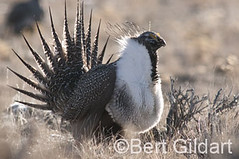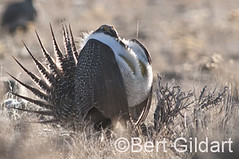Sage Grouse Lek Provides one Of Nation’s Greatest Birding Experiences
©Bert Gildart: It’s pitch black and though we’re quiet, a herd of antelope senses our presence and tests the air with a whishhhh-ing sound. But when our response doesn’t satisfy the group it gallops off into the pre-dawn light. Again, the vast prairie is quiet and we walk on, but soon hear the soft clucking of another species.
Chuck and I are hiking this expanse not too far from Bannack State Park near Dillon, Montana. We’re here to find sage grouse. Spring is the mating season for this largest of all members of the grouse family and we want to photograph their celebrated mating rituals at one of the state’s historic leks.
Even in this somewhat featureless land of three-lobed sage and big sage, Chuck knows exactly where to go. Quickly he finds what he’s looking for and begins setting up his photo blind.
We settle in to see what morning will bring. It’s cold, well below freezing, and we hunker into our down-filled parkas.
Suddenly Chuck is alert. “Here comes one,” whispers Chuck. “We may have frightened them off initially, but they’re back now!”
WORKING INTO A FRENZY
He’s right and within a few minutes the ground before us is covered with 15 to 20 males and females. Immediately several of the males begin their dance. It is an amazing thing to see.
First they thrust out their white chest feathers. Then, they begin working themselves into a frenzy, inflating their yellowish colored air sacks. Sometimes, they inflate them but partially, other times to the point where they look like huge mammary glands.
But they’re not; they are specialized sacs extending from the esophagus, apparently evolved for the sole purpose of attracting females. At the moment, however, the objects of their affections seem oblivious.
Males begin display by flaring tail feathers and puffing out chest. Sometimes it will “pace” back and forth. Next it begins to inflate its air sacs and tucks its head down all the while creating a whooomping-like sound.
But even if the females aren’t excited, I am, and though I doubt pictures will turn out in this low-light condition, both Chuck and I snap off a few images. Sunrise is still minutes away and though the birds appear as dark blobs, I hope for the best and continue with my reassurance shots. Who knows, perhaps a coyote will come along and spook the group. Or maybe a bald eagle will soar overhead. If that happens, I want some recollection of my experience, for these are amazing birds, not only because of their mating rituals, but because of their general appearance.
“COCK OF THE PLAINS”
Indeed, this “Cock of the Plains,” as Lewis and Clark called them, is a handsome bird. Adults have a long, pointed tail and leg feathers which extend down to their toes. Over the eyes there’s a yellow brow patch which contrasts with its gray head. When not inflated breasts are white, while the throat and belly range between dark brown and black.
Bodies are huge and large males may weight seven or eight pounds, making the species a prize for hunters. Ornithologists also adore the bird, but probably more for its ritualistic behavior. For these reasons the two groups often work together hoping to insure survival of this magnificent species. Unfortunately, habitat has been eliminated and with it the sage grouse has been reduced to the point where it now occupies little more than 50 percent of its former range. Leks, too, are smaller, and in some places once spread over half a mile and were hundreds of yards wide. Here, hundreds of mating birds once gathered. Sadly, that is no longer the case.
But this morning all seems right with their world, smaller though it might be. Half an hour later the sun poked its brilliant head above the horizon, and it was then that two males began competing with one another. Though the displays are conducted for the benefit of the females, males also compete physically, and this was to be one of those mornings.
Suddenly two males begin a struggle that carried them through the sage brush and off over a small knoll. Five minutes later, one returned and resumed its solo display for the nearby females.
THE ALPHA MALE
Only a few males do the breeding, and this huge fellow appeared to be the alpha male; and he was working himself into a frenzy of color and puff. Next to me Chuck’s camera whirled as he depresses the shutter and then held it down. The action was fast, and capturing some of the excitement required the assurance that only a camera with motor drive can provide.
Chuck and I continue with our fast-action photography and by mid morning realized that we’d begun to fill up the cards of our digital cameras. “Haven’t shot so many pictures in a long time,” said Chuck. Then, looking at the image counter: “I’ve taken over 300 pictures.”
Looking at my frame counter I’m astounded to see that I’d recorded a similar number. Smiling, we both agreed there wasn’t much more to do other than wait for the grouse to disperse, which they generally do, about 9. Though there’s no written rule, protocol says you should disturb the birds as little as possible.
True to form by mid morning the grounds were bare of life and we packed our equipment. We knew we’d seen something very special. In fact, some say that watching grouse on their leks is one of the nation’s top birding experiences. (Another can be seen at Bosque.)
I know two photographers who would certainly agree.
———————-







April 12th, 2010 at 1:42 pm
Hi Bert, Could you do a second short post showing some of the pre-dawn images?
I’m curious how those turned out. Even if they are blurry they may have quite an atmosphere about them. I am also interested in seeing how your Nikon handled the lighting conditions.
I love it when you post natural history topics.
~T
April 12th, 2010 at 3:07 pm
Great story and pics. Glad to hear you were turned on by nature (?).
I remember running into a MT rancher while hunting sharptail and he told the story of his shooting his first sage hen as a youngster. His dad made him eat it and it cured him forever from hunting the bird again.
While my oldest son was teaching his two boys about hunting, he emphasized that you eat what you shoot. Tony the youngest shot a robin with his BB gun he was not supposed to have out of the house. He was about eight then so his older brother (eleven) made him clean cook and eat it before dad came home from work. Of course nobody in the family will let him live that one down!
Tony has stopped shooting and eating song birds, but anything else in season better beware. He’ll be twenty next week and he’s become an excellent cook too.
Tom